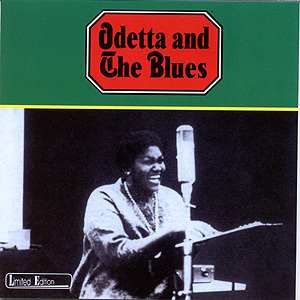|
|
|
01 |
Hard, oh Lord |
|
|
|
04:09 |
|
|
02 |
Believe I'll go |
|
|
|
03:05 |
|
|
03 |
Oh, papa |
|
|
|
03:18 |
|
|
04 |
How long blues |
|
|
|
02:10 |
|
|
05 |
Hogan's Alley |
|
|
|
02:12 |
|
|
06 |
Leavin' this morning |
|
|
|
02:50 |
|
|
07 |
Oh, my babe |
|
|
|
04:23 |
|
|
08 |
Yonder comes the blues |
|
|
|
02:51 |
|
|
09 |
Make me a pallet on the floor |
|
|
|
03:49 |
|
|
10 |
Weeping willow blues |
|
|
|
02:36 |
|
|
11 |
Go down, sunshine |
|
|
|
02:21 |
|
|
12 |
Nobody knows you when you're down and out |
|
|
|
02:20 |
|
|
|
| Country |
USA |
| Spars |
DDD |
| Sound |
Stereo |
|
|
|
Label: Riverside
Code: OBCCD-509-2 (RLP-9417)
Collection:Original Blues Classics
AAD
There s something special about Odetta s first all blues showcase beyond the significant facts that (a) Odetta as a profoundly devoted investigator of folk materials, has been involved with singing blues for the full length of her spectacular career and that (b) this particular sort of project has been a long standing passion with her
Odetta of course, is identified primarily as a folk singer -even though she has already been heard on records with The Symphony of the Air, and her standard repertoire extends as widely through several idioms as could be desired In addition to her own particular quality-a profoundly moving and emotionally communicative "feel -there is in Odetta s music an unusual technical capability that lies behind the apparent ease of what she does The skills in phrasing the fantastic swells on notes, the overall sense of control and mastery are the sort of techniques more commonly found in Schubert Lieder and may come as something of a surprise in a song like Believe I'll Go However, in Odetta's case study and training is only one segment of the musical background that has gone into her development and growth into An American Musical Institution
The route of the material hunters in today's folk music field has led into many fascinating channels, none more so than the classic blues first recorded during the 1920s and 30s Weeping Willoul and Nobody Knows You are from the Bessie Smith repertoire Make Me A Pallet is after Mama Yancev Yonder Come the Blues is in the Ma Rainey version, and Hard Oh Lord is from Ida Cox Similarly, the others presented here grow from performances originated during the era of the justly named Queens of the Blues This shouldn't carry th implication, though, that the present performances rely on the mood or feeling of the 20's Odetta is a singer of the 1960s and her music is part of her times Nor should it suggest that these blues are recent acquisitions for Odetta these songs are old friends Ever since the days when she vias first entering the professional folk music world by way of the San Francisco clubs she could be found dashing off after hours to sit in with endless mostly wildly casual little hands where shed have the opportunity to stretch out with just such blues as these in their proper setting
Furthermore there s an added challenge in this material that makes it hard to resist these are songs that were sung by women who stood at the very peak of their field in their day the material lives up to them and it demands singing that is capable of covering a powerful dramatic, and commanding range of emotions and effects And it doesn't take one long to realize how completely Odetta lives up to these demands from the total calm of Oh My Babe to the raw (and totally uncharacteristic) evil that crops up here and there
For any singer there is a particular sort of lift that can be generated only by working with a band For all the power of Odetta's more accustomed setting of guitar and bass (while she's the first to recognize the limitations of her own guitar technique the particular type of guitar throb with which she drives has already become identified in standard folk parlance as the Odetta strum' ) in the present band framework everything seems to have t feeling of fitting into place completely comfortably Both the band pulse and the interplay of solo and ensemble instrumental voices have a particular kind of effect on Odetta, turning the performances here into something totally new hut losing none of the force of her earlier work There is a unity that is especially remarkable in light of the fact that singer and musicians had never worked together before
The three mainstream horns Buck Clayton, who seems to be able to produce his own blend of grace and fire endlessly, Vie Dickenson (I don t recall who it was who said ' Nobody should be allowed to even think that way ) and Herb Hall, who shares with his celebrated brother Edmond a kind of liquid New Orleans movement spent most of their time sitting on their high stools smiling occasionally working in a little twisting Dick Wellstood, whose arrangements and piano tie the entire works together commented during the first session 1 hadn't really had a chance to hear her sing any of these things before I didn't think anybody could live up to the originals but wow. . .
Which seems to be a fair enough comment -ED MICHEL
